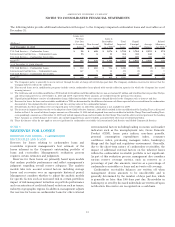American Express 2010 Annual Report Download - page 83
Download and view the complete annual report
Please find page 83 of the 2010 American Express annual report below. You can navigate through the pages in the report by either clicking on the pages listed below, or by using the keyword search tool below to find specific information within the annual report.
The following tables provide additional information with respect to the Company’s impaired cardmember loans and receivables as of
December 31:
As of December 31, 2010
Loans over
90 Days
Past Due
& Accruing
Interest
(a)
Non-Accrual
Loans
(b)
Loans &
Receivables
Modified
as a TDR
(c)
Total
Impaired
Loans
Unpaid
Principal
Balance
(d)
Average
Balance
Related
Allowance
for TDRs
(e)
(Millions)
U.S. Card Services — Cardmember Loans $ 90 $ 628 $ 1,076 $ 1,794 $ 1,704 $ 2,255 $ 274
International Card Services — Cardmember Loans 95 8 11 114 112 142 5
U.S. Card Services — Cardmember Receivables — — 114 114 109 110 63
Total
(g)(h)
$ 185 $ 636 $ 1,201 $ 2,022 $ 1,925 $ 2,507 $ 342
As of December 31, 2009 (Owned)
U.S. Card Services — Cardmember Loans $ 102 $ 480 $ 706 $ 1,288 (f) (f) $ 180
International Card Services — Cardmember Loans 147 9 15 171 (f) (f) 7
U.S. Card Services — Cardmember Receivables — — 94 94 (f) (f) 64
Total
(g)(h)
$ 249 $ 489 $ 815 $ 1,553 $ 251
(a) The Company’s policy is generally to accrue interest through the date of charge-off (at 180 days past due). The Company establishes reserves for interest that the
Company believes will not be collected.
(b) Non-accrual loans not in modification programs include certain cardmember loans placed with outside collection agencies for which the Company has ceased
accruing interest.
(c) The total loans and receivables modified as a TDR include $655 million and $586 million that are non-accrual and $7 million and $1 million that are past due 90 days
and still accruing interest as of December 31, 2010 and 2009, respectively. These amounts are excluded from the previous two columns.
(d) Unpaid principal balance consists of cardmember charges billed and excludes other amounts charged directly by the Company such as interest and fees.
(e) Reserves for losses for loans and receivables modified in a TDR are determined by the difference between cash flows expected to be received from the cardmember
discounted at the original effective interest rate and the carrying value of the cardmember balance.
(f) Detailed data for these portfolios were not required prior to December 31, 2010. This information is not available for 2009.
(g) The increase in impaired loans was due to the adoption of new GAAP effective January 1, 2010, which resulted in the consolidation of the Lending Trust as discussed
further in Note 1. As a result of these changes, amounts as of December 31, 2010 include impaired loans and receivables for both the Charge Trust and Lending Trust;
correspondingly, amounts as of December 31, 2009 only include impaired loans and receivables for the Charge Trust and the seller’s interest portion of the Lending
Trust. Amounts as of both balance sheet dates also include impaired loans and receivables associated with other non-securitized portfolios.
(h) These disclosures either do not apply or are not significant for cardmember receivables in International Card Services and Global Commercial Services.
NOTE 5
RESERVES FOR LOSSES
RESERVES FOR LOSSES — CARDMEMBER
RECEIVABLES AND LOANS
Reserves for losses relating to cardmember loans and
receivables represent management’s best estimate of the
losses inherent in the Company’s outstanding portfolio of
loans and receivables. Management’s evaluation process
requires certain estimates and judgments.
Reserves for these losses are primarily based upon models
that analyze portfolio performance and reflect management’s
judgment regarding overall reserve adequacy. The analytic
models take into account several factors, including average
losses and recoveries over an appropriate historical period.
Management considers whether to adjust the analytic models
for specific factors such as increased risk in certain portfolios,
impact of risk management initiatives on portfolio performance
and concentration of credit risk based on factors such as tenure,
industry or geographic regions. In addition, management adjusts
the reserves for losses on cardmember loans for other external
environmental factors including leading economic and market
indicators such as the unemployment rate, Gross Domestic
Product (GDP), home price indices, non-farm payrolls,
personal consumption expenditures index, consumer
confidence index, purchasing managers index, bankruptcy
filings and the legal and regulatory environment. Generally,
due to the short-term nature of cardmember receivables, the
impact of additional external factors on the inherent losses
within the cardmember receivable portfolio is not significant.
As part of this evaluation process, management also considers
various reserve coverage metrics, such as reserves as a
percentage of past due amounts, reserves as a percentage of
cardmember receivables or loans and net write-off coverage.
Cardmember receivables balances are written off when
management deems amounts to be uncollectible and is
generally determined by the number of days past due, which
is generally no later than 180 days past due. Receivables in
bankruptcy or owed by deceased individuals are written off upon
notification. Recoveries are recognized on a cash basis.
81
AMERICAN EXPRESS COMPANY
NOTES TO CONSOLIDATED FINANCIAL STATEMENTS
























